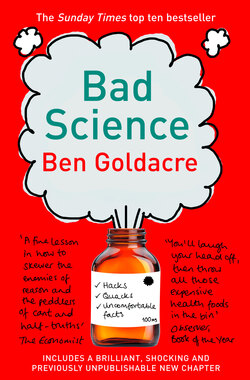Читать книгу Bad Science - Ben Goldacre - Страница 11
Detox patches and the ‘hassle barrier’
ОглавлениеLast in our brown-sludge detox triptych comes the detox foot patch. These are available in most high-street health-food stores, or from your local Avon lady (this is true). They look like teabags, with a foil backing which you stick onto your foot using an adhesive edging before you get into bed. When you wake up the next morning there is a strange-smelling, sticky brown sludge attached to the bottom of your foot, and inside the teabag. This sludge—you may spot a pattern here—is said to be ‘toxins’. Except it’s not. By now you can probably come up with a quick experiment to show that. I’ll give you one option in a footnote.*
An experiment is one way of determining whether an observable effect—sludge—is related to a given process. But you can also pull things apart on a more theoretical level. If you examine the list of ingredients in these patches, you will see that they have been very carefully designed.
The first thing on the list is ‘pyroligneous acid’, or wood vinegar. This is a brown powder which is highly ‘hygroscopic’, a word which simply means that it attracts and absorbs water, like those little silica bags that come in electronic equipment packaging. If there is any moisture around, wood vinegar will absorb it, and make a brown mush which feels warm against your skin.
What is the other major ingredient, impressively listed as ‘hydrolysed carbohydrate’? A carbohydrate is a long string of sugar molecules all stuck together. Starch is a carbohydrate, for example, and in your body this is broken down gradually into the individual sugar molecules by your digestive enzymes, so that you can absorb it. The process of breaking down a carbohydrate molecule into its individual sugars is called ‘hydrolysis’. So ‘hydrolysed carbohydrate’, as you might have worked out by now, for all that it sounds sciencey, basically means ‘sugar’. Obviously sugar goes sticky in sweat.
Is there anything more to these patches than that? Yes. There is a new device which we should call ‘the hassle barrier’, another recurring theme in the more advanced forms of foolishness which we shall be reviewing later. There are huge numbers of different brands, and many of them offer excellent and lengthy documents full of science to prove that they work: they have diagrams and graphs, and the appearance of scienciness; but the key elements are missing. There are experiments, they say, which prove that detox patches do something … but they don’t tell you what these experiments consisted of, or what their ‘methods’ were, they only offer decorous graphs of ‘results’.
To focus on the methods is to miss the point of these apparent ‘experiments’: they aren’t about the methods, they’re about the positive result, the graph, and the appearance of science. These are superficially plausible totems to frighten off a questioning journalist, a hassle barrier, and this is another recurring theme which we will see—in more complex forms—around many of the more advanced areas of bad science. You will come to love the details.
